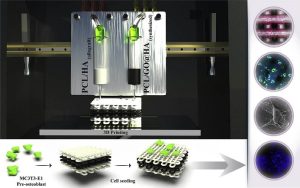3D-Printed hetero-layered composite Scaffold for Enhanced Bone Regeneration
Table of contents
Negar Rashidi, Najmeh Najmoddin, Amir Hossein Tavakoli, Reza Samanipour
Innovative 3D Printed Hetero-Layered Composite Scaffold Boosts Osteogenic Differentiation of Pre-Osteoblast MC3T3-E1 Cells
DOI: 10.1016/j.surfin.2024.104683
Key Features of the Research
In the evolving realm of bone tissue engineering, our recent study in R&D team of company (Regen Allograft) presents a novel 3D printed hetero-layered composite designed to enhance osteogenic differentiation in pre-osteoblast MC3T3-E1 cells. This research addresses the pressing need for effective alternatives to autografts and Bone Allograft products for treating bone injuries.
Utilizing advanced dual nozzle 3D printing, we developed a biomimetic structure that integrates both natural and synthetic components to optimize healing. The primary material is poly(ε-caprolactone) (PCL), known for its biocompatibility and biodegradability. A significant innovation involves incorporating synthetic hydroxyapatite (HAs) decorated on graphene oxide (GO) sheets, which enhance mechanical properties while providing essential biological cues for effective cellular response.
To maximize potential, we engineered the structure by layering with naturally sourced allograft hydroxyapatite (HAa) on both upper and lower surfaces. This design mimics the natural extracellular matrix, crucial for cell adhesion, proliferation, and differentiation.
Our findings indicate that the developed material supports enhanced cell attachment and significantly increases levels of osteogenic differentiation compared to conventional alternatives. This was demonstrated through assays such as alizarin red staining, alkaline phosphatase (ALP) activity, and osteo-related gene expression analysis. FE-SEM imaging confirmed successful printing and structural integrity, showcasing a highly regular architecture.
Mechanical testing revealed that incorporating GO@HAs substantially improved Young’s modulus and overall strength. Notably, adding HAa did not compromise mechanical properties, indicating the composite maintains structural integrity while enhancing biological functionality.

3D-Printed Hetero-Layered Composite Scaffold
Conclusion: A New Horizon in Bone Tissue Engineering
In summary, this innovative 3D printed hetero-layered composite presents a promising solution for effective bone repair, addressing limitations of existing grafting methods. By combining mechanical robustness with biological efficacy, the material opens new avenues for advancements in bone tissue engineering. This research not only highlights the potential of engineered solutions in regenerative medicine but also paves the way for future explorations into biomaterials and their applications in treating complex bone injuries.
Explore our published paper and how this technology could transform the future of bone repair please refer this link.
How useful was this post?
Click on a star to rate it!
Average rating 0 / 5. Vote count: 0
No votes so far! Be the first to rate this post.
Relevant Posts

Free consultation
Do you need counseling?
The professional and specialized team at Allograft is ready to assist you


